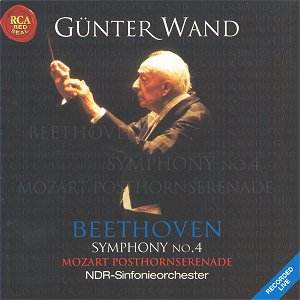 Composer: Ludwig van Beethoven
Composer: Ludwig van Beethoven
Works: Symphony No. 4 in B flat major, Opus 60; Posthorn Serenade, K320
Performers: North German Radio Symphony Orchestra; Günter Wand, conductor
Recording: Live performances recorded 8-10 May 2001, Musikhalle, Hamburg
Label: RCA RED SEAL 74321 89717 2
Ludwig van Beethoven’s Fourth Symphony, composed between 1806 and 1807, occupies a unique position within the classical canon. Nestled between the monumental Third and the revolutionary Fifth, this symphony often evokes a sense of cheerfulness and intimacy, qualities that are sometimes overshadowed by its more famous siblings. Beethoven’s ability to balance exuberance with lyrical grace is particularly evident in this work. The RCA recording under Günter Wand, featuring the North German Radio Symphony Orchestra, captures this essence with both clarity and depth, offering a refreshing perspective on the symphony’s intricate textures and vibrant themes.
Günter Wand’s interpretation is marked by a thoughtful yet vigorous approach, reflecting his deep affinity for Beethoven’s nuanced style. The performance opens with a splendid Maestoso introduction, which Wand takes with a confidence that sets the stage for the lively Allegro that follows. The orchestra responds with a bright, agile sound, and the strings in particular demonstrate a remarkable cohesiveness in articulating the driving motifs. Wand’s handling of dynamics allows the music to breathe, deftly transitioning between the symphony’s contrasting moods. The Scherzo is a highlight, with its playful rhythms and lively character brought to life through precise ensemble playing. The buoyancy of the orchestral texture here is palpable, underscoring the joy inherent in Beethoven’s writing.
While the Andante offers a moment of calm and introspection, it is also where the performance encounters a slight challenge. The tension that typically underpins this movement occasionally falters, as the pacing risks losing momentum. However, Wand’s ability to restore energy with the ensuing Allegro ma non troppo is commendable, reinvigorating the performance with an infectious spirit. The final movement bursts forth with exuberance, and Wand artfully emphasizes the wit embedded in Beethoven’s themes. The crisp articulation of the woodwinds and the robust support from the brass section create an exhilarating culmination to the symphonic journey.
The recording quality enhances the live performance experience, with well-balanced sound engineering that captures the orchestral colors vividly. The clarity of the individual sections, particularly the blending of woodwinds and brass, allows listeners to appreciate the intricate counterpoint that characterizes Beethoven’s writing. Compared to other notable recordings, such as those by Herbert von Karajan or Leonard Bernstein, Wand’s interpretation stands out for its straightforwardness and authenticity, favoring the music’s inherent charm over dramatic exaggeration.
The coupling with Mozart’s Posthorn Serenade adds a delightful layer to this release, showcasing Wand’s versatility and deep understanding of classical repertoire. The serenade, with its charming use of the posthorn motif, is performed with an infectious vitality that complements Beethoven’s symphonic exuberance. Wand’s attention to detail, particularly in the balance of the ensemble, highlights Mozart’s wit and grace, making it a fitting companion piece.
The RCA RED SEAL recording of Beethoven’s Fourth Symphony and Mozart’s Posthorn Serenade under Günter Wand is a significant contribution to the recording legacy of these works. Wand’s interpretations resonate with a blend of affection and insight, bringing forth the joyous spirit of Beethoven while also illuminating the subtleties of Mozart’s craftsmanship. This recording not only serves as a testament to Wand’s artistry but also reaffirms the enduring relevance of these masterpieces in the classical canon.



